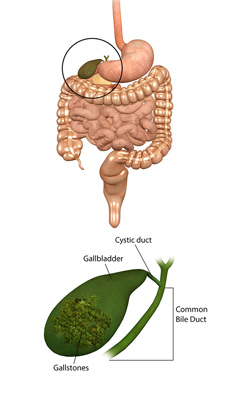
Gallstones are quite common; worldwide about one out of ten person suffers from gallstone. Most of the people suffering from gallstone may not be aware of the fact that they have gallstone as the condition is asymptomatic (silent) in most of them. In symptomatic cases, common presenting symptoms include sudden onset severe pain on the upper part of the abdomen which may radiate towards the right shoulder and usually last for minutes to hours.
There are several complications of gallstones; the most important ones are pancreatitis, acute cholangitis, choledocholithiasis (migration of gallstone from the gall bladder to the common bile duct) etc.Surgery is the mainstay of treatment for gallstone although in asymptomatic cases as such no treatment is required.
Causes
Bile or gall is a bitter tasting digestive juice produced by the liver cells in most of the vertebrates including humans and stored and concentrated in the gall bladder, from where it reaches the small intestine (the duodenum) after food enters the digestive tract.Bile is mainly composed of water (92%) along with bile salts, bilirubin, fats (mainly cholesterol) and other inorganic salts.
The common causes associated with gallstone formation include
1) Imbalance of the different constituents of the bile: this is one of the principal factors responsible for gallstone formation. Whenever there is excess cholesterol and small amount of bile salts in the bile there is chance of precipitation of the excess cholesterol in the form of bile stones.
2) Inadequate emptying of gall bladder of bile: Sometimes gallstones can occur despite normal balance between cholesterol and bile salts. Inadequate contraction of gall bladder both in terms of frequency and intensity may lead to inadequate removal of bile from the gallstone and overconcentration of the bile leading to gallstone formation.
3) Sometimes besides inadequate emptying of gall bladder may be accompanied with high resistance to outflow of bile from the gall bladder due to complex geometric structure of the cystic duct (the tube like structure which drains bile from the gall bladder).
4) There are certain physiological conditions in which the level of circulating estrogen increases in the women especially, in pregnancy or during intake of hormonal contraceptives. These may lead to increase the cholesterol level and interfere with the normal functioning of the gall bladder.
5) Excessive amount of bilirubin may also be responsible for gallstone formation. There are certain health conditions in which there is excess production of bilirubin due to increased breakdown of RBCs takes place. Such health conditions include suffering from hemolytic anemia like hereditary spherocytosis, sickle cell anemia, etc.
Types of gall stones
Gallstones can be of various sizes as small as a grain or sand to as large as a golf ball. As per composition of the gallstones there are several types of gallstones; these are
1) Cholesterol stones: this variety of gallstones are characterized by light yellow to dark green or brown stones, usually oval in shape about 2 to 3 cm in length. This type of gallstones typically has a black central spot. Cholesterol is the principal component of this variety of gallstones (about 80%).
2) Pigment stones: this variety of gallstones are mainly composed of bilirubin and calcium containing salts with about 20% cholesterol and usually dark brown to black in color.
3) Mixed gallstones: this type of gall stones contain about 20 to 30% of cholesterol along with calcium carbonate, palmitate phosphate, bilirubin, different bile pigments, etc.





